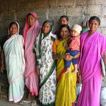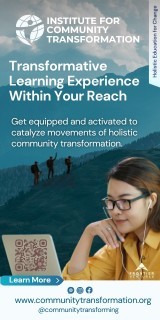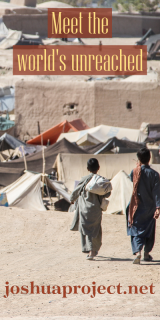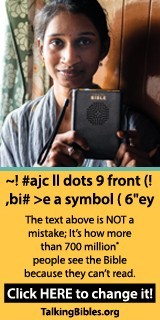Microfinance
A Look at the Technique as an Effective Strategy for Poverty Alleviation

Hope in the slums
In the slums of several cities in Western India, the financially poor are gathering to save. In groups of 10 to 12, they come together to receive business training, contribute $2 a month to a joint savings account for productive investment or to meet family needs, and learn about the love of Christ.
As members of India’s two lowest castes, many of HOPE India’s* clients are initially skeptical of its approach: “Why are you wasting your time with us?” they ask staff members. “We’re poor. We’re stuck here, and there is no way out for us.”
Believing that “there is no way out” is one of the most damaging aspects of financial poverty. If life will never get better, why try? If there’s no hope, why dare to dream?
Staff members of this Christ-centered microfinance organization respond by telling clients, “You’re created in God’s image, and He has a plan and a future for all of you.” As clients come to believe this message, they are in turn empowered to enact change in their communities. Progress is slow, but unmistakable - businesses are created, families have the financial resources to put their children in school, dignity is restored, and the voiceless speak. In one district of the slums, a savings group successfully petitioned the local government council to have electricity installed where there had previously been none. Instead of remaining resigned to their fate, these individuals now have hope and are working to build a brighter future.
Microfinance under fire
Contrast their example with that of Andhra Pradesh, India, where riots and scandal have exposed the ugly underside of microfinance. Until recently, microfinance—offering financial services such as small loans and savings services to the poor—was the darling of the international development sector. With its leveraged approach to reaching the poor and its philosophy of promoting client dignity, microfinance appealed to those across the political, social, and economic spectrum.
But when more than 30 loan clients committed suicide in Andhra Pradesh, and high-profile microlenders were accused of abusing clients’ rights, its image changed overnight.
Instead of being seen as the silver bullet to end poverty, it became synonymous with exorbitant interest rates and questionable repayment practices. Although much of the scandal was limited to the region of Andhra Pradesh, the damage to microfinance’s image was worldwide.
These two situations paint very different pictures of the effectiveness of microfinance and illustrate some of the tensions within the sector. Done well, microfinance can be a powerful tool for good. Done poorly—whether intentionally or accidentally—this powerful tool can further harm some of societies’ most vulnerable. In order to ensure that microfinance remains an effective tool for alleviating poverty and helping—not hurting—the poor, it is important to address these tensions by keeping clients at the forefront and prioritizing impact on individual families.
Credit versus training
As highlighted by the crisis in India, simply handing someone a loan is not enough: Without business training, clients are more likely to make poor investments. Without a place to save and accumulate capital, families may become hooked on a never-ending cycle of unproductive credit. The practice of just offering small loans, microcredit, has been replaced with an understanding that realizing positive change requires more than just a loan.
In HOPE’s programs, not only are clients encouraged to save, but they also learn biblically based business principles that teach them how to open and sustain a business. In India, clients receive training that equips them to make items like handbags and baked goods, as well as opportunities to sell the items they create at churches and local retailers.
Saturation versus need
With the growing popularity of microfinance and the incredibly high repayment rates of borrowers, Andhra Pradesh attracted microlenders interested in more than helping the poor. It appealed to payday lenders, loan sharks and anyone who was looking to make a quick buck. Inundated by multiple groups with a variety of motives, Andhra Pradesh became a place where receiving credit was like buying bottled water, with vendors offering loans on practically every street. With no peer screening or accountability, clients were taking multiple loans, using loans from one lender to repay another, and becoming over-indebted in the process.
However, across the world, the majority of people still do not have any access to basic financial services. Fewer than 20 percent of the global need for microfinance services is currently being served (and less than 1% of the global need is served by faith-based organizations), according to the World Bank’s Consultative Group to Assist the Poor (CGAP). When HOPE first entered the Democratic Republic of Congo, for example, there were only 65,000 bank accounts for a population of 65 million – 1 in a thousand. For these individuals, microfinance fills a large gap, providing access to capital, savings accounts and training to those who wouldn’t otherwise have any access.
Short-term versus long-term impact
Given this tremendous unmet demand, the question is whether or not the Church should become involved in meeting it. Is it a wise use of resources? Does it align with the global mission of alleviating human suffering and pointing people to Jesus? Does it make an impact?
There are a variety of impact assessment studies on microfinance. In most, the stories of individual clients may not appear very dramatic to those in wealthy nations—and may not even show up as a blip on a country’s GNP. But for someone earning a dollar a day, adding a second dollar can make a huge difference. This 100 percent increase in income would likely lead that client’s family to eat better, enjoy better health, improve their housing, and experience greater confidence and hope for the future.
Instilling this hope for the future is an important aspect of microfinance. FINCA, a leading microfinance network, reports that 93 percent of its clients have all of their school-aged children in school. John Hatch, FINCA’s founder, encourages us to look at the “intergenerational” changes that are occurring: even if today’s clients do not escape poverty in their lifetime, they are equipping their children with the education that will help them break free of the generational cycle of poverty.
In Rwanda, HOPE has seen similar results in its partnership with the Anglican Church to provide those in poverty with training and a safe place to save their money. Of HOPE’s nearly 70,000 clients in Rwanda, school attendance increased from 28 percent of members’ children to 71 percent, even as church attendance increased from 65 percent of clients to 96 percent.
Spiritual transformation
Microfinance has played a key role in impacting much more than just physical poverty. At a recent meeting of one of HOPE’s savings groups in India, a client stepped forward and said, “Before, we were called slum dwellers, but this is no longer how we view ourselves in our hearts. We have hopes, we have dreams, and we want to continue moving forward in God’s vision.”
Christ centered and client focused, HOPE India’s message to the poor is that they are made in the image of God—that they have dignity, talents, and potential. By communicating this message in word and deed, they are seeing lives transformed. Microfinance is not a panacea, but if used correctly, it is a powerful tool that equips individuals to free themselves from the bonds of physical and spiritual poverty.
*In India, HOPE partners with an organization whose name has been withheld for security.









comments